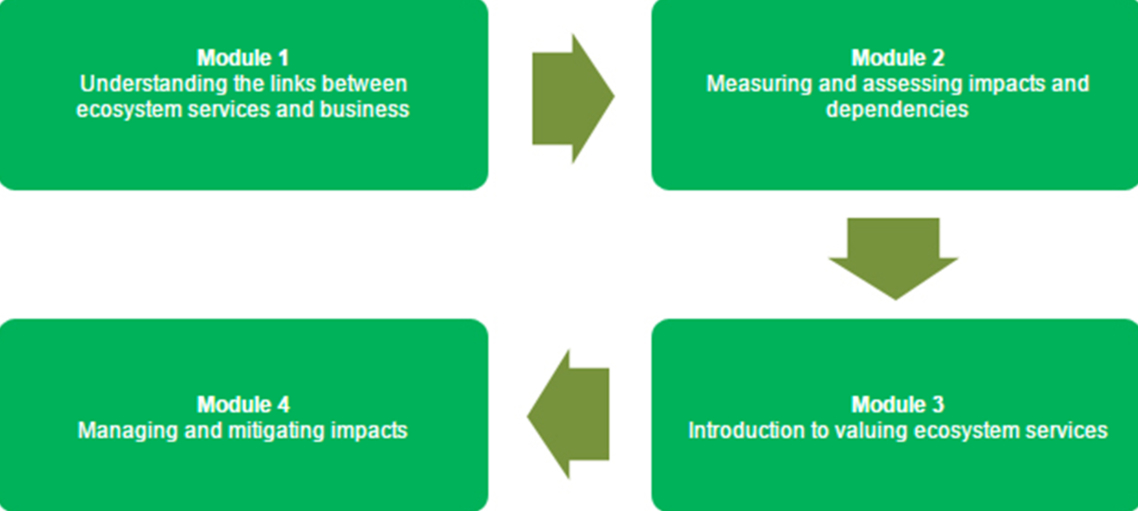BET is, in principle, a linear training program, i.e. the audience needs to follow each module one after the other. However, the modules are developed in such a way to allow them to be used individually if necessary (e.g. module 3 could be used on its own, for an audience that already have some environmental and sustainability expertise). Therefore the materials provided should be tailored prior to delivering the course, in order to ensure that the specific needs of the participants are met.
The course is split into the following four modules:
Module 1 – Understanding the links between ecosystem services and business
Learning objectives
By the end of the module, trainees will be able to:
- Demonstrate an understanding of the key terms and concepts around biodiversity, ecosystems, ecosystem services, environment and sustainability.
- Identify the direct and indirect drivers and causes for biodiversity and ecosystem changes and impacts, and the impacts and dependency of companies on ecosystems services.
- Understand the link between wider sustainability issues and ecosystems services.
- Describe the business case for managing ecosystems, and identify the specific business case for their own company, from the perspective of both risk and opportunity.
- Understand some of the basic regulatory and policy frameworks currently in place as a key driver of change (module 4 will cover this topic in detail).
- Retain knowledge that will help them add value to their organization.
- Help participants gain knowledge that will help them add value to their organization.
Module 2 – Managing and mitigating impacts
Learning objectives
By the end of the module, trainees will be able to:
- Define key terms and concepts with regard to measuring ecosystem services impacts and dependency.
- Understand the business case for assessing impacts and dependencies on ecosystems.
- Apply the Ecosystem Services Review (ESR) framework/methodology to identify impacts and dependencies on ecosystems services.
- Conduct an initial assessment of their company’s impacts, following the application of the ESR in a case study and the action planning exercise to identify relevant and applicable tools.
Module 3 – Introduction to valuing ecosystem services
Learning objectives
By the end of the module, trainees will be able to:
- Identify the business case for valuing ecosystems services.
- Understand the principles and key stages of a Corporate Ecosystem Valuation.
- Examine case studies of companies which have commissioned valuation studies, and understand how and when it is appropriate to screen and use ecosystem valuation.
Module 4 – Managing and mitigating impacts
Learning objectives
By the end of the module, trainees will be able to:
- Define key policies and policy mechanisms for addressing and mitigating environmental impact, as well as enhancing business practice for better management.
- Identify the business case for managing and mitigating impacts.
- Apply the mitigation hierarchy i.e., develop ideas on how their company can mitigate, offset and provide compensation for their impacts.
- Identify how regulatory frameworks and policy mechanisms relate to a delegate’s employer, through action planning.

